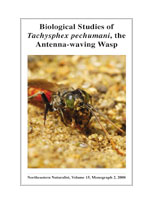Tachysphex pechumani, the antenna-waving wasp, has a disjunct geographic distribution in the Lower Peninsula of Michigan, Indiana Dunes, Oak Openings of Ohio, southern Ontario, and New Jersey pinelands. This distribution is tied to excessively/well-drained sandy soils, oak/pine-dominant barrens, savanna and woodland, climate moderation related to proximity to large bodies of water, habitat fragmentation from natural causes and human disturbance, and 20th-century land preservation. The 550-km gap between subpopulations in southwestern Ontario and southern New Jersey may be the consequence of Early Holocene pine-dominant barrens, savanna, and woodland being supplanted by deciduous and deciduous-coniferous forest on loamy sand in the northeastern United States during the past 6000 years. A plausible scenario as to where T. pechumani lived during the past 18,000 years and what dispersal route(s) enabled it to attain its current geographic distribution is presented.
BioOne.org will be down briefly for maintenance on 17 December 2024 between 18:00-22:00 Pacific Time US. We apologize for any inconvenience.
How to translate text using browser tools
1 March 2008
I. Geographic Distribution and Paleobiogeography of Tachysphex pechumani (Hymenoptera: Crabronidae)
Frank E. Kurczewski
ACCESS THE FULL ARTICLE

Northeastern Naturalist
Vol. 15 • No. sp5
March 2008
Vol. 15 • No. sp5
March 2008




